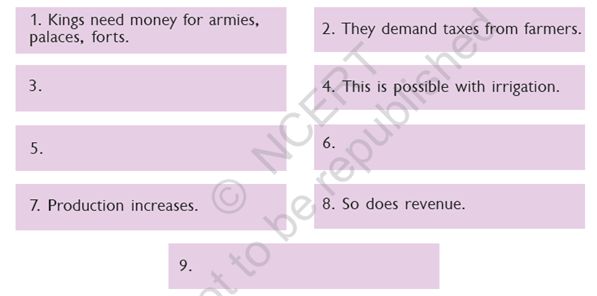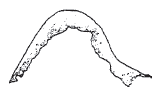History - Class 6
Our Past - I
Chapter 8: Vital Villages, Thriving Towns
Intext Questions:
Question 1. Choose the right one for each of the pictures. 1)Sickle, 2) tongs, 3) axe.
Answer:
Question 2. Prepare a list of at least five objects made of iron or steel that you use almost everyday.
Answer:
- Vehicles – cars, trucks, SUVs, semis, RVs, buses, trains.
- Appliances – refrigerators, washing machines, clothes dryers, stoves, dishwasher.
- Utensils – forks, spoons, knives and more.
- Medical – surgical stainless steel, implantable devices.
Question 3. Fill in the rest by using the following phrases:
- Labour is provided by the people.
- Farmers also benefit because crop production is more certain.
- Farmers have to increase production to pay taxes.
- Kings provide money and plan irrigation works.

Answer:
3. Farmers have to increase production to pay taxes
5. Kings provide money and plan irrigation works
6. Labour is provided by the people
9. Farmers who benefit because crop production is more certain
Question 4. List the occupations of the persons mentioned in the story. For each one, try and decide whether they would have lived:
- only in villages
- only in cities
- in both cities and villages
Answer: The occupations mentioned in the story are-
- Hotel owner – lived in the city
- Gardener – both in the villages and city
- Potter – lived in the villages
- Grasscutter – villages
- Horse merchant (trader) – both in the villages and city
- Trader – city
Question 5. Why do you think the horse dealer was coming to the city?
Answer: The horse dealer was coming to the city to sell his horses because he had 500 horses and wanted to sell them to make a profit.
Question 6. Do you think women could have taken up the occupation mentioned in the story? Give reasons for your answer.
Answer: Women could have taken up some occupations :
- Hotel owner – It is time-consuming, needing a long horse of work. It cannot be taken up by women.
- Gardener – the women can take up the job, as it is not a laborious job.
- Potter – making pottery is also an easy job, needing more skill, to make different shapes and design.
- Grass cutter – cutting grass is time-consuming but easy to work.
- Traders – usually they work in the cities or go from one city to another. Many times the traders have to stay overnight or for many days. Hence cannot be taken up by women.
Question 7. Ring well found in Delhi. In what ways do you think this system of drainage was different from that of the Harappans?
Answer: The ancient cities had ring- well system. It is a rows of pots or ceramic rings arranged one on top of other. They have been used as toilet in some areas and as drains and garbage 'lumps. These ring wells have been found. in individual houses whereas Harappans used underground drainage system.
Question 8. Notice the way walls are shown. Are they made of brick, wood or stone? Now look at the railings. Are they made of wood?
Answer: The walls were made of stone. The railings were made of brick. They are not made of wood.
Question 9. Make a list of all the things imported and exported from Barygaza. Underline at least two things that were not in use during Harappan times. Why do you think merchants brought gifts for the king?
Answer: Goods exported and imported from Bharuch (Barygaza) are:-
Exports :
- Plants form the Himalayas
- ivory
- agate
- camelina
- cotton
- silk
- perfumes
Imports :
- wine
- copper
- tin
- lead
- coral
- topaz
- cloth
- gold and silver coins
The two things that were not in use during Harappan times are :
- gold and silver coins
- plants from the Himalayas
Question 10. Salt was produced plentifully from the sea coast. What are the merchants planning to exchange it with? How are they traveling?
Answer: The merchants wanted to exchange paddy for salt. They are travelling in carts, with their families.
Question 11. Make a list of the occupations of the people who lived in Mathura. List one occupation that was not practiced in Harappan cities.
Answer: The main occupations of the people were:
- Goldsmiths
- Blacksmiths
- Weavers
- Basket-makers
- Garland-makers
- Perfumers
Question 12. Make a list of all the women who could be employed by the superintendent. Do you think women would have faced any problems while working?
Answer: Arthashastra mentions the rules for spinning and weaving. It describes how this process can be carried out under the supervision of the special official. The rules were:
- All the people like young women, nuns, mothers, retired women servants of the king, women who have retired from service in temples, may be used for processing wool, bark, cotton, hemp, and flax.
- They should be paid according to the quality and quantity of the work done.
- Women who were not permitted to leave their homes could take the services of the maidservant.
- Women had to give their work in the morning and get wages. If a woman did not complete her work, she was severely punished. She had to pay a fine, sometimes her thumbs were cut off.
- Superintendent had to be discreet while talking to the women, otherwise, he was punished.
Question 13. List the evidence that indicates that there was contact with Rome.
Answer: Roman designs were used in locally made pottery. Roman lamps, glassware and gems have also been found at many sites.
Question 14. Why do you think the amphitheatres and aqueducts have survived?
Answer: The amphitheatres and aqueducts were made of bricks and cement mortar. Romans were the first to find cement.
Imagine
Question: You live in Barygaza and are visiting the port. Describe what you would see there.
Answer: I saw that the gulf is very narrow at Barygaza and very hard to navigate for those coming from the sea. Ships had to be steered in by skilful and experienced local fishermen who were employed by the king. Special gifts were brought by merchants for the king. These included vessels of silver, singing boys, beautiful women, fine wines and fine cloth.
Let's recall
Question 1. Fill in the blanks:
- ________ was a word used for large landowners in Tamil.
- The gramabhojaka often got his land cultivated by the ________ .
- Ploughmen were known as ________ in Tamil.
- Most grihapatis were ________ landowners.
Answer:
- Vellalar
- Slaves and hired workers
- Ezhava
- Smaller
Question 2. Describe the functions of the gramabhojaka. Why do you think he was powerful?
Answer: The ‘gramabhojaka’ was the largest landowner. He had slaves and he hired workers to cultivate the land. He was powerful since the king entrusted him with the important job of collecting taxes from the villagers. His other functions were those of a policeman and judge.
Question 3. List the crafts persons who would have been present in both villages and cities.
Answer: Craftsperson who would have been present in both villages and cities were :
- Blacksmiths
- Carpenters
- Weavers
Question 4. Choose the correct answer :
- Ring wells were used for:
- bathing
- washing clothes
- irrigation
- drainage
- Punch marked coins were made of:
- silver
- gold
- tin
- ivory
- Mathura was important:
- village
- port
- religious center
- forested area
- Shrines were associations of:
- rulers
- craftspersons
- farmers
- herders
Answer: 4. drainage
Answer: 1. silver
Answer: 3. religious center
Answer: 2. craftspersons
Let’s discuss
Question 5. Which of the iron tools shown on page 79 would have been important for agriculture? What would the other tools have been used for?
Answer: Ploughshares would have been important for agriculture. The other tools used were sickles and axes. The other tools like tongs, nails, and hammers were used for carpentry and also by ironsmiths.
Question 6. Compare the drainage system in your locality with that of the cities mentioned in the lesson. What similarities and differences do you notice?
Answer: The drainage system in the cities in the present times is highly developed. There is an underground drainage system with covered drains. The bathrooms, toilets, and kitchens have an underground system and are connected to the main drains outside. The ancient cities had a ring well system. It is a row of pots or rings arranged one on top of others. They have been used as toilets in some cases and as drains and garbage dumps. These ring wells have been found in individual houses.
| Ancient cities | Present cities |
|---|---|
| Toilets in the houses. | Toilets in the houses, with cisterns and flushes. |
| Ring wells used as garbage bins. | In present times, there are garbage pins where garbage from the whole city is dumped. |
Let’s do
Question 7. If you have seen crafts persons at work, describe in a short paragraph what they do. (Hint: how do they get the raw materials, what kind of equipment they use, how do they work, what happens to the finished product).
Answer: I have seen crafts persons like weavers, blacksmiths, goldsmiths in villages and cities. Weavers are mostly seen in villages. I saw them running their spinning wheel or handmill. First, they collect the cotton balls, they weave thread and then they weave clothes. After that, they sell it in the market.
Question 8. List the functions performed by men and women who live in your city or village. In what ways are these similar to those performed by people who lived in Mathura? In what ways are they different?
Answer: In the city I live in, I see men and women working to feed their families. Most men work in offices and other establishments. Women also work in offices these days. In a city like Mathura, people worked to provide food items to the city- folks because it was located at the intersection of two major trade and travel routes. The life of people of our cities and that in Mathura was in no way much different.


